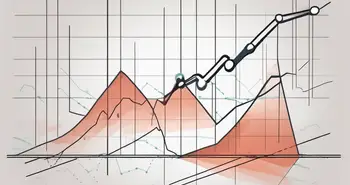Understanding the Capital Asset Pricing Model: A Comprehensive Guide

In the world of finance, there are numerous investment models and theories that help investors make informed decisions. One such model that has gained significant popularity is the Capital Asset Pricing Model (CAPM). CAPM provides a comprehensive framework for understanding the relationship between risk and return in the context of investment decisions. In this guide, I will take you through the various aspects of CAPM, from its fundamental concepts to its application in real-world scenarios.
Introduction to Capital Asset Pricing Model (CAPM)
Let's begin by understanding what CAPM is all about. At its core, CAPM is a mathematical model used to determine the expected return on an investment based on its systematic risk. This model assumes that investors are rational and risk-averse, and they consider two factors when making investment decisions: the risk-free rate of return and the incremental return associated with taking on additional risk.
But what exactly is systematic risk? Systematic risk refers to the risk that affects the entire market or a specific industry, rather than being specific to an individual investment. It includes factors such as economic conditions, interest rates, and market sentiment. CAPM takes into account this systematic risk to estimate the expected return on an investment.
The Fundamental Concepts of CAPM
To grasp the essence of CAPM, it's crucial to familiarize yourself with some fundamental concepts. The first concept is the risk-free rate, which represents the return an investor can expect to receive on an investment with no risk. Typically, this is associated with government bonds.
For example, if the risk-free rate is 3%, it means that an investor can earn a guaranteed return of 3% by investing in a risk-free asset, such as a government bond. This rate serves as a benchmark for evaluating the expected returns of other investments.
The next concept is beta, a measure of a security's volatility in relation to the overall market. A beta greater than 1 indicates that the security is more volatile than the market, while a beta less than 1 suggests lower volatility. Beta is a key component of CAPM as it quantifies the relationship between an investment's risk and its expected return.
For instance, if a stock has a beta of 1.5, it means that the stock is expected to be 50% more volatile than the overall market. This higher volatility is compensated by a higher expected return, according to CAPM.
Lastly, we have the market risk premium, which represents the excess return an investor expects to earn by investing in the overall market as opposed to the risk-free asset. The market risk premium captures the additional compensation investors demand for taking on the risk associated with investing in the market.
For example, if the risk-free rate is 3% and the market risk premium is 5%, it means that investors expect to earn an additional 5% return by investing in the market compared to a risk-free asset. This premium reflects the risk-reward trade-off that investors consider when making investment decisions.
The Importance of CAPM in Finance
Now, you might wonder why CAPM is so important in the field of finance. The answer is simple: CAPM provides investors with a tool to evaluate and compare investment options based on their risk and expected returns. By using CAPM, investors can determine whether an investment is offering adequate compensation for the risk being taken.
Furthermore, CAPM has practical applications in various areas of finance, such as portfolio management and corporate finance. It helps portfolio managers make optimal investment decisions by considering the risk-return trade-off. By analyzing the beta of different securities, portfolio managers can construct diversified portfolios that balance risk and return.
In the realm of corporate finance, CAPM can be used to determine the cost of capital for a company, aiding in capital budgeting decisions. The cost of capital represents the minimum return a company must earn on its investments to satisfy its shareholders. By estimating the cost of capital using CAPM, companies can evaluate the feasibility of potential projects and make informed decisions about allocating resources.
In conclusion, CAPM is a powerful tool that allows investors to assess the expected return of an investment based on its systematic risk. By considering factors such as the risk-free rate, beta, and market risk premium, investors can make informed decisions about their investment portfolios. Additionally, CAPM has practical applications in portfolio management and corporate finance, making it an essential concept in the field of finance.
The Mathematical Framework of CAPM
Now that we have covered the basic concepts, let's delve into the mathematical framework of CAPM.
The Capital Asset Pricing Model (CAPM) is a widely used financial model that helps investors determine the expected return on an investment based on its risk. It provides a framework for understanding the relationship between risk and return in the context of the overall market.
At the core of CAPM are several key components that work together to calculate the expected return on an investment. These components include the risk-free rate, beta, and the market risk premium.
The Risk-Free Rate
The risk-free rate forms the foundation of CAPM. It represents the return an investor can earn on an investment with no risk. The risk-free rate is typically determined by government bond yields, as they are considered to have negligible default risk. In practice, the risk-free rate is often approximated by the yield on short-term Treasury bills.
The risk-free rate serves as a benchmark against which the expected return on an investment is compared. It provides a baseline for investors to assess the risk and potential return of other investments. By subtracting the risk-free rate from the expected return on an investment, investors can determine the risk premium associated with that investment.
It is important to note that the risk-free rate is not constant and can vary over time. Factors such as inflation, monetary policy, and economic conditions can influence the level of the risk-free rate.
Beta and Market Risk Premium
Another crucial component of CAPM is beta. Beta measures the sensitivity of a security's returns to the overall market returns. A beta of 1 indicates that the security's returns move in lockstep with the market, while a beta greater than 1 suggests higher volatility. Conversely, a beta less than 1 implies lower volatility compared to the market.
Beta is calculated by comparing the historical returns of a security to the historical returns of the market index. It provides investors with an indication of how much risk is associated with a particular investment relative to the overall market.
The market risk premium is the additional return an investor expects to earn by investing in the overall market rather than the risk-free asset. It can be calculated by subtracting the risk-free rate from the expected return on the market index.
The market risk premium reflects the compensation investors require for taking on the additional risk associated with investing in the market. It represents the potential reward for bearing market risk and serves as a key input in the CAPM formula.
By incorporating beta and the market risk premium into the CAPM formula, investors can estimate the expected return on an investment based on its level of risk. This allows investors to make informed decisions about the potential risk and return trade-offs of different investments.
It is important to note that CAPM has its limitations and assumptions. It assumes that investors are rational and risk-averse, markets are efficient, and there are no transaction costs or taxes. Despite these assumptions, CAPM remains a valuable tool for understanding the relationship between risk and return in the financial markets.
Assumptions Behind the CAPM
As with any model, CAPM is built upon certain assumptions that may not always hold true in the real world. Nevertheless, these assumptions provide a foundation for the model's applicability.
Let's delve deeper into the assumptions behind the Capital Asset Pricing Model (CAPM) and explore their implications.
Investor Behavior and Market Assumptions
CAPM assumes that investors are rational and risk-averse. This means that investors carefully consider the risk and return of a security or portfolio when making investment decisions. Rationality implies that investors weigh the potential gains against the risks involved, seeking to maximize their utility.
Furthermore, the model assumes that investors have homogeneous expectations and freely share information. This assumption suggests that all investors have access to the same information and analyze it in a similar manner. It leads to the concept of an efficient market, where prices reflect all available information accurately and promptly. In an efficient market, it is difficult for investors to consistently outperform the market by exploiting mispriced securities.
However, in reality, investors may have different risk preferences, access to information, and behavioral biases that can influence their decision-making process. Market efficiency can also be compromised due to information asymmetry, where some investors possess privileged information that others do not.
Risk and Return Assumptions
CAPM assumes that investors are solely concerned with the systematic risk of an investment, which cannot be diversified away. Systematic risk refers to the risk that affects the entire market or a specific segment of it, such as changes in interest rates, economic conditions, or geopolitical events. This assumption implies that investors are not concerned with idiosyncratic risk, also known as unsystematic risk, which can be eliminated through diversification.
Additionally, CAPM assumes that the relationship between risk and return is linear. According to this assumption, an increase in the level of risk corresponds to higher expected returns. This implies that investors require compensation for taking on additional risk in the form of higher expected returns. However, in practice, the relationship between risk and return may not always be linear. Different assets and markets may exhibit nonlinear relationships, where higher risk does not necessarily guarantee higher returns.
It is worth noting that these assumptions are simplifications of the complex reality of financial markets and investor behavior. While CAPM provides a useful framework for understanding the relationship between risk and return, it is important to consider its limitations and the potential impact of deviations from these assumptions in real-world scenarios.
The Application of CAPM in Investment Decisions
Now that we have a solid understanding of the key components of CAPM, let's explore how it can be applied in real-world investment decisions.
Portfolio Management and CAPM
Portfolio management involves constructing a well-diversified portfolio that maximizes returns for a given level of risk. By using CAPM, portfolio managers can assess the risk and expected return of individual assets and their contribution to the overall portfolio. This enables them to make informed decisions about asset allocation and risk management.
CAPM in Corporate Finance
CAPM plays a vital role in corporate finance, particularly in estimating the cost of capital for a company. The cost of capital represents the return required by investors to invest in a company's projects. By applying CAPM, companies can determine the appropriate discount rate for their future cash flows, helping them evaluate the profitability and feasibility of investment opportunities.
Criticisms and Limitations of the CAPM
While CAPM has proven to be a valuable tool in many respects, it is not without its criticisms and limitations.
Empirical Validity of CAPM
One of the main criticisms of CAPM is its empirical validity. Critics argue that the model's assumptions may not hold true in reality, leading to a disconnect between predicted and actual returns. The validity of CAPM has been the subject of extensive research, with mixed results. It is important for investors to consider the limitations and conduct thorough analysis before relying solely on CAPM.
Alternative Models to CAPM
Over time, alternative models have emerged that aim to address the limitations of CAPM. Some prominent examples include the three-factor model and the Fama-French five-factor model. These models incorporate additional factors, such as size and value, to better explain the variation in stock returns. While these models provide valuable insights, they too have their own limitations and may not be applicable in all situations.
FAQs
1. What is CAPM?
CAPM, or the Capital Asset Pricing Model, is a mathematical framework used to determine the expected return on an investment based on its systematic risk.
2. How is risk-free rate determined?
The risk-free rate is typically determined by government bond yields, such as short-term Treasury bills, due to their minimal default risk.
3. Why is CAPM important in finance?
CAPM allows investors to evaluate and compare investment options based on their risk and expected returns. It also has practical applications in portfolio management and corporate finance.
4. Are there any limitations to CAPM?
CAPM is not without its limitations. Its assumptions may not always hold true in reality, and alternative models has emerged to address its shortcomings.
-
- What are some alternative models to CAPM?
Alternative models to CAPM include the three-factor model and the Fama-French five-factor model, which incorporate additional factors to better explain stock returns.
Now armed with a comprehensive understanding of the Capital Asset Pricing Model, you can make more informed investment decisions. While CAPM is a valuable tool, it is important to consider its limitations and conduct further analysis to ensure the best outcomes for your investment portfolio.
Remember, investing is a journey, and it's essential to constantly educate oneself and adapt to the evolving financial landscape. By staying informed and keeping an eye on market trends, you can navigate the world of investments with confidence and success.
As you explore the intricacies of the Capital Asset Pricing Model and consider its application in your investment strategy, take the opportunity to experience the future of trading with Morpher. Embrace a platform where blockchain technology enhances your trading capabilities, offering zero fees, infinite liquidity, and the flexibility of fractional investing. With Morpher, you can confidently navigate the markets, whether you're looking to invest in stocks, cryptocurrencies, or even the most unconventional assets. Ready to revolutionize your trading journey? Sign Up and Get Your Free Sign Up Bonus at Morpher.com today and join a community of investors who are already shaping the world of finance.

Disclaimer: All investments involve risk, and the past performance of a security, industry, sector, market, financial product, trading strategy, or individual’s trading does not guarantee future results or returns. Investors are fully responsible for any investment decisions they make. Such decisions should be based solely on an evaluation of their financial circumstances, investment objectives, risk tolerance, and liquidity needs. This post does not constitute investment advice.

Painless trading for everyone
Hundreds of markets all in one place - Apple, Bitcoin, Gold, Watches, NFTs, Sneakers and so much more.

Painless trading for everyone
Hundreds of markets all in one place - Apple, Bitcoin, Gold, Watches, NFTs, Sneakers and so much more.









